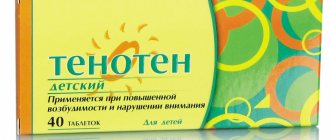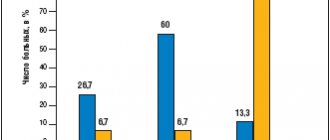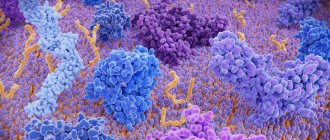Betadine
Betadine (povidone-iodine) is an antiseptic drug for use in gynecological practice. Today, not a single home first aid kit is complete without an antiseptic - a means for disinfecting the skin and treating the wound surface. Iodine solution has long been considered one of the classic antiseptics. Betadine from the Hungarian pharmaceutical company EGIS Pharmaceuticals, having absorbed all the benefits of iodine, thanks to a more advanced formula, does not irritate the mucous membranes, which allows it to be used in gynecology as a vaginal antiseptic. Since the inclusion of the first antiseptic in the arsenal of doctors in the mid-19th century, the range of representatives of this pharmacological group has increased significantly, making it more difficult for the consumer to choose. Requirements for a truly effective antiseptic include:
• ability to be active against a wide range of pathogens;
• lack of tolerance of microorganisms;
• an impressive list of indications for use;
• favorable safety profile, lack of systemic effects;
• performance.
Betadine has all of the above advantages. It contains povidone-iodine, which is bound to a carrier - polyvinylpyrrolidone. Polyvinylpyrrolidone is a synthetic polymer that is devoid of toxic properties and does not exhibit antigenic activity, which is capable of reversibly binding other substances. With iodine, it forms a hydrophilic complex in the ratio of its own molecules to iodine 19 to 1. Upon contact with the skin and mucous membranes, the complex of iodine with polyvinylpyrrolidone disintegrates, and the former begins to have a pronounced disinfecting effect against gram-positive and gram-negative aerobes and anaerobes, viruses, protozoa, and fungi . Such a wide therapeutic range allows Betadine to be in demand in various fields of medicine, including gynecology, surgery, traumatology, dermatology, and burn medicine. The mechanism of action of povidone-iodine is the inactivation and destruction of amino acids of bacterial enzymes and structure-forming proteins, which leads to the death of infectious agents.
It is very important that to date, not a single case of the development of microbial resistance to povidone-iodine has been registered in medicine, which significantly expands the range of its use. A common pathogen such as Staphylococcus aureus (including its methicillin-resistant strains) is sensitive to Betadine. To date, impressive clinical experience has been accumulated in the use of Betadine. It is known that it remains stable and does not reduce its effectiveness in the presence of blood, purulent exudate, or vaginal secretions. The speed of onset of the antibacterial effect of the drug is also worthy of mention - only 15-45 seconds. Indications for the use of Betadine include vaginal infections, cuts, burns, pyoderma, trophic ulcers, bedsores with microbial contamination. The drug in the form of vaginal suppositories can be used for acute and chronic vulvovaginitis caused by Trichomonas and Candida (especially after the use of systemic antibacterial drugs and corticosteroids). The hydrophilic base of the suppositories eliminates irritating effects on the skin and mucous membranes. Betadine has a favorable safety profile and is well tolerated by patients. Today, this drug is the “gold standard” for the treatment of a number of vaginal infections, including vulvovaginal candidiasis, nonspecific and viral vaginitis, trichomonas colpitis, and bacterial vaginosis. Betadine, as already noted, is not absorbed into the systemic bloodstream (when used in recommended doses for a period of time prescribed by the doctor), therefore the side effects it causes are exclusively local in nature - itching, hyperemia, allergic reactions. Betadine is contraindicated starting from the third month of pregnancy and throughout the entire period of breastfeeding. When using vaginal suppositories, the use of pads is allowed.
About the use of the drug "Betadine" in surgical practice
Ershova A.K.
Currently, the incidence of infectious wound complications in surgical practice is not decreasing, despite the introduction of new, modern methods of prevention and treatment. The success of a well-performed complex surgical operation is negated by the development of postoperative purulent complications. And the increase in cases of generalization of infection and toxic-allergic reactions not only complicates treatment, but also leads to a significant increase in the time of hospital stay and an increase in the cost of treating patients [1]. Therefore, the correct choice of an antiseptic is important not only from the point of view of effective treatment of purulent diseases and their complications, but also taking into account pharmaco-economic aspects.
In more than 60% of cases, surgical wound infections are caused by 7 types of bacteria: 19% - Escherichia coli, 18.3% - Staphylococcus aureus, 8.8% - Proteus spp., 8.7% - Pseudomonas aeruginosa, 3.9% - Bacteroides spp., 2.6% – Streptococcus spp., 1.1% – Clostridium perfringens [2]. Infectious complications in surgical hospitals develop most often in the area of the surgical incision; Also, do not forget about post-injection, catheter-associated infections [3] and purulent complications, which are often encountered in the formation of bedsores.
To solve the problem of infectious complications in surgery, it is necessary first of all to influence the causative agent of the infection. The leading role in this, undoubtedly, is occupied by antibiotic therapy, which, in connection with the development and improvement of bacteriological diagnostic methods, should ideally be based on the accurate isolation and identification of microorganisms, especially when it comes to nosocomial pathogens. Another important aspect in the prevention and treatment of infectious complications in a surgical hospital is local treatment using local forms of antibiotics and local antiseptics.
Local antiseptics are divided into eleven main groups: 1 - group of halogens, including iodine preparations, 2 - oxidizing agents, 3 - acids, 4 - aldehydes, 5 - phenols, 6 - alcohols, 7 - hypertonic solutions, 8 - dyes, 9 – salts of heavy metals, 10 – detergents and 11 – nitrofuran derivatives. An important feature of modern infection is the presence of several pathogens, both aerobic and anaerobic [4], often resistant to most antibiotics. Resistance to many antiseptic drugs has also become increasingly common [5,6].
Currently, a large number of antiseptic agents are known that have good bactericidal properties [7]. However, recently, research results demonstrate that some strains of microorganisms, especially hospital ones, become resistant to many antiseptics (aqueous solution of chlorhexidine, potassium permanganate solution, furatsilin, etc.). In this regard, an active search is underway for new drugs that reliably prevent the spread of hospital infections. Thus, well-known preparations of iodine, and in particular its various complex compounds, are increasingly used. In this regard, the drug “Betadine” (pharmaceutical, Hungary) deserves special attention. This iodophor is a broad-spectrum antiseptic with bactericidal, sporicidal and antiviral properties [2]. The biologically active substance of the drug is povidone-iodine (in the form of polyvinylpyrrolidone iodine complex), the antimicrobial effect of which is due to oxidative damage and blocking the microorganism cell membrane. Povidone-iodine has been widely used in surgical practice for more than 30 years, starting from the 70–80s of the last century [8,9].
“Betadine” is an antiseptic and disinfectant drug, the antimicrobial effect of which, as mentioned above, is based on iodine damaging the cell wall of pathogenic microorganisms due to the oxidation of amino acids in bacterial proteins containing SH- and OH- groups. These are mainly bacterial enzymes and transmembrane proteins. During oxidation, their quaternary structure changes and they lose their catalytic and enzymatic activity. The compound of iodine with polyvinylpyrrolidone is a synthetic polymer that does not have toxic or antigenic properties, which is capable of reversibly attaching other substances, such as medicinal toxins, drugs, hormones [2]. In combination with polyvinylpyrrolidone, iodine loses its ability to cause tissue burning when applied, but retains high bactericidal activity, which has expanded the scope of its use as an antiseptic. Thanks to the polymer molecule, iodine penetrates deep into the wound, into inflamed tissue and under the scab. "Betadine" has a wide spectrum of antimicrobial action, showing high activity against gram-negative (E. coli, K. pneumoniae, Mycobacterium tuberculosis, Neisseria gonorrhoeae, Proteus spp., Ps. aeruginosa, Salmonella typhi, Shigella spp.), gram-positive microorganisms (Bacillus subtilis, Bacillus subtilis, Clostridium perfringens, Clostridium tetani, Propionibacterium acnes, S. aureus, Str. pyogenes), fungi (Aspergillus niger, Candida albicans, Microsporum audouinii, Nocardia spp., Penicillium spp., Triphophyton spp.), as well as spore-forming flora, protozoa, treponemes, some viruses [9–12]. Particularly important is the fact that, despite the long period of use of povidone-iodine in surgical practice, the most common infectious agents have not acquired resistance to this drug [9,13–15].
Compared to other antiseptics, Betadine has a number of important advantages: it retains antiseptic properties for a long period of time on the skin; retains high antiseptic properties even in the presence of blood and plasma; does not cause the development of resistant forms of microorganisms; highly soluble in water; non-toxic with prolonged and frequent use; rarely causes allergic reactions and is shelf stable.
"Betadine" is indicated for use for the prevention of infectious complications in the following clinical situations [2]:
• treatment of fresh soft tissue wounds;
• treatment of the skin of the surgical field;
• skin treatment before blood collection, biopsy, diagnostic and therapeutic punctures;
• treatment of mucous membranes;
• treatment of “donor” wounds;
• treatment of sutures of postoperative wounds;
• processing of transplants.
As a treatment for infectious complications that have already arisen, Betadine is indicated for use in [16–19]:
• burns;
• purulent postoperative wounds;
• diabetic and atherosclerotic gangrene;
• post-traumatic purulent wounds, osteomyelitis, purulent arthritis;
• trophic ulcers and bedsores;
• washing postoperative chest wounds after open heart surgery;
• treatment of purulent wounds, fistulas due to pacemaker rejection;
• injection into cysts of parenchymal organs.
It is also possible to use povidone-iodine when treating the abdominal cavity after planned and emergency operations and when managing open peritonitis; when treating the pleural cavity after emergency and planned operations for acute and chronic purulent processes, especially in patients with tuberculosis [2].
The most common problem in surgical practice is purulent wounds that occur as a result of complications of traumatic skin injuries, surgical treatment of acute and chronic purulent-inflammatory diseases of soft tissues and bones (phlegmon, abscess, osteomyelitis, etc.) and various other infectious postoperative complications. The course of such wounds is often aggravated by the presence of atherosclerosis of the lower extremities and/or diabetes mellitus, etc. Most often, wound infection occurs in the form of wound suppuration. Clinically, swelling and redness in the affected area, pain on palpation, purulent or serous-purulent discharge, and the presence of necrosis are noted. When a significant volume of soft tissue surrounding the wound is involved in the destructive purulent-inflammatory process, phlegmon occurs [12,20]. In the case of exuding wounds, pyoderma, dermatitis and eczema often develop on the adjacent skin.
In the treatment of various wound processes, the drug "Betadine" has established itself as a highly effective and easy-to-use antiseptic, as was shown in a study by V.V. Michalski et al. [21]. The purpose of this work was to evaluate the effectiveness of the use of the drug "Betadine" in the treatment of patients with wounds of various etiologies. The results of treatment of 114 patients were analyzed, all patients were divided into 2 groups: Group 1 (68 people) – patients in whom Betadine was used in complex therapy. Group 2 (56 people) – patients who used Levomikol ointment for local therapy. Dressings were performed daily. After sanitizing the wound surface with antiseptic solutions, the wound was dried and sterile napkins moistened with Betadine solution or soaked in Betadine ointment were applied to it. As a result of the study, it was shown that when treating wounds with Betadine, a clear regression of the inflammatory process was observed during the first 5–7 days: tissue swelling around the affected area disappeared, the amount of purulent discharge decreased, pain in the wound disappeared or became less intense. When using Betadine, there was a decrease in wound contamination below a critical level, less than 103 CFU/g by 7.2 days, while in the group using the drug Levomikol by 9.9 days, which is due to a wider spectrum of antimicrobial activity " Betadina." When treated with Betadine, a pronounced anti-inflammatory effect was noted, wound cleansing occurred within 2 days. earlier than when using Levomikol (8.1 and 10.2 days, respectively). The appearance of the first granulations was recorded at 10.2 and 13.5 days. The first signs of marginal epithelization in group 1 appeared after 13.9 days, while in group 2 – at 2.6 days. Later. In all cases (n=68), the use of Betadine was not accompanied by the development of side effects. As a result of summarizing all the data obtained, it was demonstrated that wound cleansing when using Betadine occurred faster than in the comparison group.
However, we should not forget about the contraindications to the use of the drug "Betadine", which are:
• hypersensitivity to iodine and other components of the drug;
• hyperthyroidism or other severe thyroid dysfunction (including nodular colloid goiter, endemic goiter, Hashimoto's thyroiditis and thyroid adenoma);
• condition before and after the use of radioactive iodine in the treatment of hyperthyroidism, after scintigraphy with the use of radioiodine (until complete recovery);
• dermatitis (especially Dühring's dermatitis herpetiformis);
• renal failure.
"Betadine" is available in the form of a 10% solution of 30, 120 and 1000 ml (respectively containing 3, 12 and 100 g of a complex compound of iodine with polyvinylpyrrolidone) and 10% ointment of 20 g (containing 2 g of a complex compound of iodine with polyvinylpyrrolidone) .
Thus, modern antiseptic drugs containing povidone-iodine, in particular Betadine, are highly effective in the prevention and treatment of purulent-inflammatory processes in clinical practice. The drug "Betadine" has a wide range of antimicrobial and fungicidal activity and, importantly, is well tolerated by patients with a minimum number of adverse reactions. High clinical and bacteriological effectiveness combined with a high safety profile indicate the need for wider use of the antiseptic drug Betadine in surgical practice.
Literature
1. Belozer A.A., Smirnov O.A., Petkova V.A. Infection control of nosocomial infections in an emergency hospital. Collection of materials of the 3rd Russian scientific and practical conference “Modern problems of epidemiology, diagnosis and prevention of nosocomial infections.” St. Petersburg, 2003; 75–7.
2. Blatun L.A. Modern iodophors are effective drugs for the prevention and treatment of infectious complications. Consilium medicum. 2005, volume 7 no. 1.
3. Lode H. Catheter-associated infections in the ICU. Proceedings of the International Conference “Nosocomial Infections in Intensive Care Units”. 1998; With. 15–6.
4. Kuzin M.I., Kostyuchenok B.M., Kolker I.I. and others. Anaerobic non-clostridial infection in surgery (methodological recommendations). M., 1987; from 29.
5. Goldatein FW et al. S. aureus Strain Largely Resistant to Triclosan: French Study. 44th ICAAC, Washington, 2004.
6. Geissler A, Gerbeaux P, Granier I et al. Rational use of antibiotics in the intensive care unit: impact on microbial resistance and costs. Intensive Care Med 2003; 29 (1): 49–54.
7. Langer S, Sedigh Salakdeh M et al. The impact of topical antiseptics on skin microcirculation. Eur J Med Res 2004; 9 (9): 449–54.
8. Surgical infections /Manual edited by I.A. Eryukhina, B.R. Gelfanda, S.A. Shlyapnikov. M. – 2003. – 854 p.
9. L.A. Blatun. Local medicinal treatment of wounds. Problems and new possibilities for solving them // Consilium Medicum. Surgery. – 2007, vol.9. – No. 1.
10. Bulynin V.I., Glukhov A.A., Moshurov I.P. Treatment of wounds. / Voronezh. – 1998. – 248 p. 6.
11. Methodological guidelines for the treatment of wounds: Transl. with him. / Ed. G. Herman. – Medica, 2000. – 123 p. 7.
12. Nazarenko G.I., Sugurova I.Yu., Glyantsev S.P. Wound, bandage, patient. M.: Medicine, 2002. – 472 p.
13. Datsenko B.M. Theory and practice of local treatment of purulent wounds. Problems of drug therapy. – K.: Health, 1995. – 344 p.
14. Osipov I.S., Leonov S.V. Use of the antimicrobial agent "Betadine" in a surgical clinic. M: “Egis” – 1990. – No. 3. – P.7–10.
15. Zamora JL Povidone–iodine and wound infection. // Surgery – 1984, V. 95. – R. 121–122. 15. Zellner PR and Bugyi S. Povidone–iodine in the treatment of burn patients. – //Journal of Hospital Infection, 1985, V. 6. – R. 139–140.
16. Ley R. Traitement local des brulures. Panoplie et therapy. Acta chir Belg 1975; 74 (5): 483–99.
17. Babb JR, Briges K, Jackson DM et al. Topical chemoprophylaxis: Trial in silver phosphate chlorhexidine silver, sulphadiazine and povidone iodine preparations. Burns 1977; 3 (2): 65–71.
18. Stohes EJ, Howand E, Peters JC et al. Comporison of Antibiotic and Antiseptic Prophylaxis of wound infection in Acute Abdominal surgery. World J Surg 1977; 7(6):777–82.
19. Shelling CF. Comparative evalution of pouvidon – iodine aerosol, foam, solution and silver sulfadiazine cream as prophylactic topical antibacterial agents for treatment of the burn wound. Rurns 1980; 7 (2): 143–9.
20. Surgical infections of the skin and soft tissues. Russian national recommendations. / Guide edited by V.S. Savelyeva. M. – 2009. – 89 p.7.
21. Mikhalsky V.V., Goryunov S.V., Bogdanov A.E., Zhilina S.V., Prividentsev A.I., Anikin A.I., Ulyanina A.A. /Use of the drug “Betadine” in the treatment of infected wounds. // Russian medical journal. Surgery. Urology - 2010, v. 18. – No. 29., 1780–1788.
Betadine 200 mg 14 pcs. vaginal suppositories
pharmachologic effect
Antiseptic.
Composition and release form Betadine 200 mg 14 pcs. vaginal suppositories
Suppositories - 1 sup.:
- active ingredient: 200 mg of povidone-iodine (corresponds to 18 - 24 mg of active iodine) in each vaginal suppository;
- Excipient: macrogol 1000 2800 mg.
7 vaginal suppositories in a blister made of PVC/PE film.
1 or 2 blisters in a cardboard box along with instructions for use.
Description of the dosage form
Vaginal suppositories are torpedo-shaped, homogeneous, dark brown in color.
Directions for use and doses
Intravaginally (For insertion into the vagina).
To maximize the release of the active substance and prevent the development of local irritation, it is recommended to moisten the suppository with water and insert it deep into the vagina in the evening before bed. If menstruation begins while using the vaginal suppository, treatment should be continued without interruption for the prescribed period of time.
Insert 1 suppository deep into the vagina: for acute vaginitis, 1 time per day for 7 days; in more severe cases or if the therapeutic effect is insufficient, treatment can be continued for the next 7 days, 1 time per day. For persistent, long-term infections, treatment may be longer and vaginal suppositories can be used 2 times a day.
For preoperative prevention of complications of infectious origin in gynecology, the drug is administered intravaginally 2 times a day (morning and evening before bedtime) for 1-7 days.
If there is no improvement after treatment or the symptoms worsen or new symptoms appear, you should consult your doctor. Use the drug only according to the indications. according to the method of use and in the doses indicated in the instructions for use.
Pharmacodynamics
Povidone iodine is a complex of iodine and a polymer of polyvinylpyrrolidone that releases iodine over a period of time after its application. Elemental iodine (I2) has a strong germicidal effect. In in vitro experiments, it quickly destroys bacteria, viruses, fungi and some protozoa. Its mechanism of action is as follows: free iodine has a rapid germicidal effect, and the polymer is a depot for iodine. Upon contact with skin or mucous membranes, the polymer releases ever-increasing amounts of iodine. Iodine reacts with the oxidizable -SH and –OH groups of amino acids that are part of the enzymes and structural proteins of microorganisms, inactivating or destroying these proteins, leading to the death of microorganisms.
Most microorganisms are destroyed when exposed in vitro in less than 1 minute, with the main destructive effect occurring in the first 15 - 30 seconds, while the iodine becomes discolored. Therefore, the intensity of the brown color is an indicator of effectiveness. Resistance to the drug is unknown.
Antimicrobial spectrum of action: the active ingredient of the drug vaginal suppositories Betadine effectively affects and destroys a wide range of microorganisms, such as gram-positive and gram-negative bacteria (bactericidal effect), viruses (virucidal effect), fungi (fungicidal effect), some protozoa (protozoocidal effect ) and spores (sporicidal effect).
Pharmacokinetics
When applied topically, there is almost no reabsorption of iodine from the mucous membrane.
Indications for use Betadine 200 mg 14 pcs. vaginal suppositories
Acute or chronic vaginitis (mixed, nonspecific infection), bacterial vaginosis (caused by Gardnerella vaginalis), candidiasis, Trichomonas vaginalis infection.
Vaginal infections following antibiotic or steroid therapy.
Prevention before surgical or diagnostic interventions in the vagina.
Contraindications
Hypersensitivity to povidone-iodine and other components of the drug.
Thyroid dysfunction (hyperthyroidism) (see section Special instructions).
Other acute diseases of the thyroid gland.
Dühring's dermatitis herpetiformis.
Before or during the use of radioactive iodine for the treatment of thyroid carcinoma or scintigraphy.
Pregnancy and lactation period.
For girls under adolescence, the use of Betadine vaginal suppositories is contraindicated.
Application Betadine 200 mg 14 pcs. vaginal suppositories during pregnancy and breastfeeding
The use of Betadine® is not recommended from the 3rd month of pregnancy and during lactation (breastfeeding). If necessary, in these cases, treatment is possible under individual medical supervision. Contraindicated in premature and newborn babies.
special instructions
With prolonged use of the drug, skin irritation, contact dermatitis or hypersensitivity may develop. If signs of local irritation and hypersensitivity appear, the use of the drug should be discontinued.
Do not heat the drug before use.
In patients with thyroid diseases such as goiter, nodular goiter and other non-acute thyroid diseases, the administration of significant amounts of iodine can cause hyperthyroidism. In such patients, the use of Betadine vaginal suppositories should be limited in time. If signs of hyperthyroidism develop at the end of treatment, patients are advised to monitor thyroid function.
The drug should not be used before or after scintigraphy, as well as during treatment of thyroid carcinoma with radioactive iodine (see section Contraindications).
Particular caution should be observed when using the drug regularly in patients with impaired renal function.
Regular use of Betadine vaginal suppositories should be avoided in patients receiving lithium preparations.
Caution is recommended when administering vaginal suppositories to virgins.
Suppositories have a spermicidal effect, and therefore their use is not recommended in women planning pregnancy.
It is also recommended to use sanitary pads during the course of treatment.
Coloring on skin and fabrics is washed off with water. After contact with the drug, avoid contact with the eyes.
Children and teenagers
For girls under adolescence, the use of Betadine vaginal suppositories is contraindicated.
Impact on the ability to drive vehicles and operate machinery
The drug does not affect the ability to drive or engage in other potentially hazardous activities that require increased concentration and speed of psychomotor reactions.”
Overdose
When using the drug in accordance with the instructions for use, an overdose is unlikely. With excessive use, iodine intoxication is possible, which is characterized by the following symptoms: metallic taste in the mouth, increased salivation, burning or pain in the mouth or throat, irritation and swelling of the eyes, skin reactions, gastrointestinal disorders and diarrhea, impaired renal function and anuria , circulatory failure, laryngeal edema with secondary asphyxia, pulmonary edema, metabolic acidosis, hypernatremia.
Treatment: symptomatic and supportive therapy with special attention to electrolyte balance, renal and thyroid function.
Side effects Betadine 200 mg 14 pcs. vaginal suppositories
Itching, hyperemia at the injection site, allergic reactions.
If you experience the side effects listed in the instructions, or they get worse, or you notice any other side effects not listed in the instructions, tell your doctor.
Drug interactions
The povidone-iodine complex is effective in the pH range 2 - 7. The interaction of the complex with proteins and other unsaturated organic substances reduces its effectiveness.
The drug should not be used with other disinfectants and antiseptics containing oxidizing agents, alkalis and cationic surfactants. If you are using the above or other medications (including over-the-counter medications), consult your doctor before using Betadine.
The oxidative effect of povidone-iodine can lead to false-positive results of various diagnostic tests (for example, determination of hemoglobin in stool or urine or glucose in urine).
During use of povidone-iodine, iodine uptake by the thyroid gland may be decreased, which may affect the results of some diagnostic tests (eg, thyroid scintigraphy, protein-bound iodine, and radioactive iodine) or make planned iodine therapy for the thyroid gland impossible. In order to obtain objective results after long-term treatment with povidone-iodine, it is necessary to take a break before performing scintigraphy.
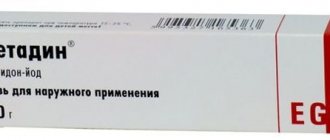

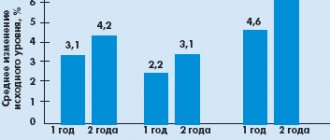
![Table 2. Comparison of the antiviral effects of some antiseptics [R. Kawana et al., 1998]](https://laram-halal.ru/wp-content/uploads/tablica-2-sravnenie-protivovirusnogo-dejstviya-nekotoryh-antiseptikov-r-kawana-i-330x140.jpg)
